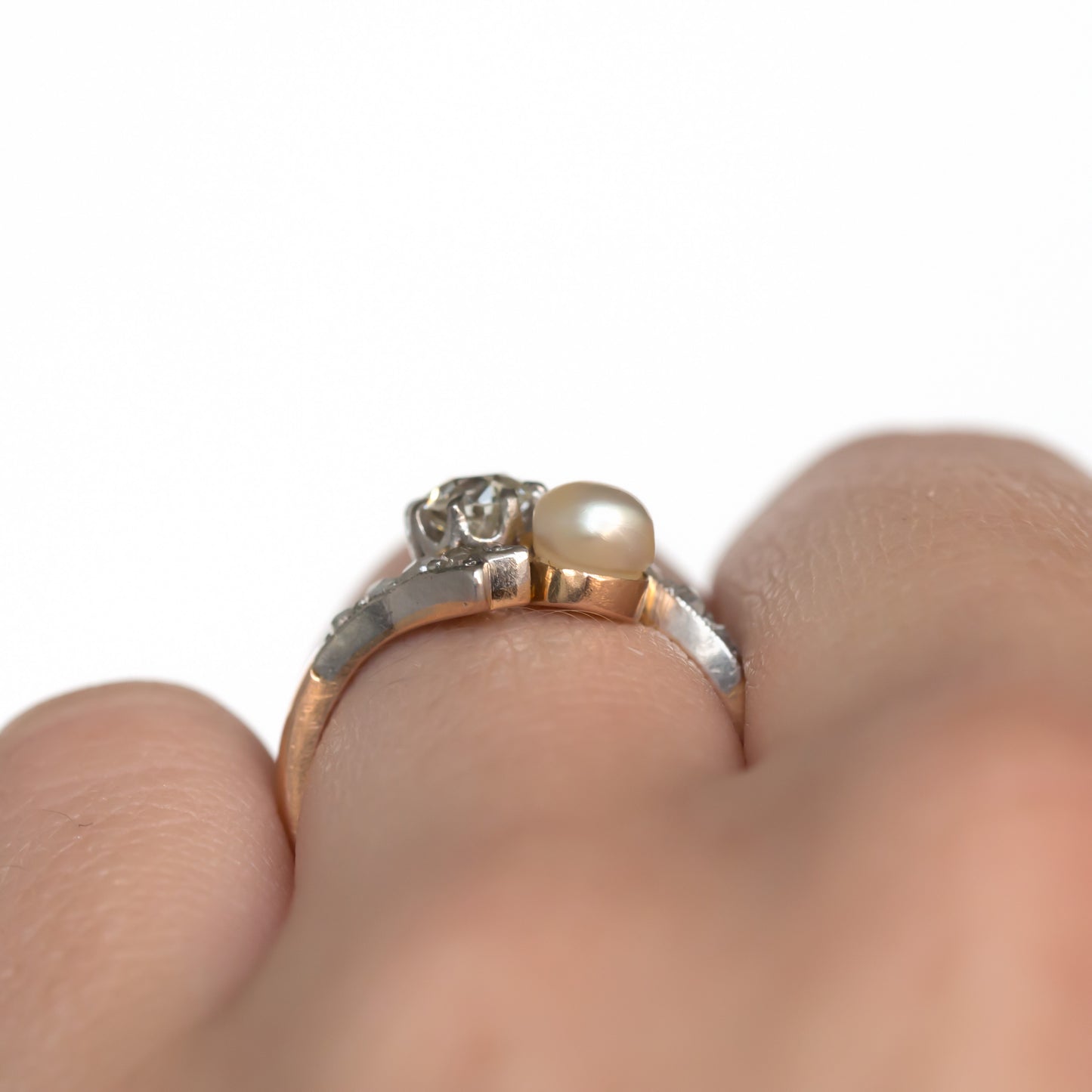The Verma Group
Liberty Street
Liberty Street
Couldn't load pickup availability
Circa 1880s 14K Rose Gold & Platinum Top .45ct Old European, .10cttw Rose Cut Diamond and .40ct Pearl Cocktail Ring - VEG#1147
This piece is a 1880s Victorian era 14K Rose Gold and Platinum top ring with a .45ct Old European cut center diamond, .10cttw Rose cut side stones and a .40ct natural pearl! The center diamond and pearl lay nicely next together with ribbon-like shoulders of the band come and touch both stones in a romantic, lovely way!
Ring Size: 4.5
Metal Type: 14k Rose Gold and Platinum Top
Weight: 3.0 grams
Center Diamond Details:
Shape: Old European
Carat Weight: .45 ct
Color: J
Clarity: VS
Side Stone Details:
Shape: Rose Cut
Total Carat Weight: .10cttw
Color: J
Clarity: VS
Color Stone Details:
Type: Natural Pearl
Carat Weight: .40ct
Finger to Top of Stone Measurement: 4.61mm
Victorian Era:
Time Period: The styles of the Victorian wedding ring and engagement ring were defined by the reign of Queen Victoria from 1837 - 1901 and her everlasting affection for her beloved husband Albert. Victoria too had a great influence on the jewelry styles of the time, and it was her great love of diamonds that led to a revolution in diamond rings. The Victorian era is separated into three distinct times - which all have their own unique styles and history. These are the Early Victorian period, the Mid-Victorian period and the Late Victorian period.
Description of Era: Changes to the metals and diamond gemstones used to create wedding rings and engagement rings occurred during the Victorian eras.
The first was the introduction of lower karat gold alloys; before 1854, precious rings were created mainly with 22k or 18k gold (75% pure gold alloyed with copper, silver, nickel, or a mixture of these metals) and silver, but after 1854 the gold standards changed and rings created with 15k gold, 12k gold, and 9k gold became legal on the market.
The second important change was the opening of the South African diamond mines in 1870; before 1870 diamonds were quite rare and most diamond rings contained clusters of small diamonds, but after 1870 when the South African mines opened large diamonds became available for use in wedding rings and engagement rings.
Early Victorian Wedding Rings: 1837-1860
Early Victorian wedding rings symbolized the heydays of the early reign of Queen Victoria and her marriage to Albert. The Victorian snake ring became extremely popular during Queen Victoria's first years of marriage because Albert had given her a snake and emerald engagement ring. Whatever Queen Victoria wore soon became 'all the rage', and from this time on the Victorian snake ring enjoyed years of popularity.
Gemstones included amethyst, bloodstone, chalcedony, garnet, moss agate, ruby, smoky quartz, and topaz. Many engagement rings included the bride’s birthstone. Rings often included multiple gemstones and other types of materials such as coral, ivory, tortoise shell, and seed pears. In some cases, inlaid images were placed under a gemstone.
Diamond rings often included small clusters of diamonds or small diamonds which framed circular or square shaped gemstones. The most popular diamond cuts of the day were the new "brilliant" cut and the old world rose cut.
Ring metals of the time included 22k and 18k gold, rose gold, pinchbeck (a gold imitation made with copper and zinc) and in later years 9k, 12k and 15k gold.
Popular motifs included natural themes like butterflies, clover, garlands, daisies, doves, Gothic symbols and letters plus snakes.
Mid-Victorian Wedding Rings: 1860 - 1885
During the Mid-Victorian period, rings began to shift in style. Albert passed away in 1861, and memorial rings (also known as mourning rings) became very popular again (they were initially common during the Georgian era). Victorian engagement rings and wedding rings from this middle era are made from silver and various gold karat alloys (18k, 15k, 14k, 12k, and 9k). Rose gold rings created from gold alloyed with copper also became very popular during this time. Popular gemstones and designs during the Mid-Victorian period included opals, crystals, emeralds, diamonds, pearls, black glass, jet, and the ruby. Designs become less ornate and more refined. Rings were made by handcrafting. Popular jewelry design motifs included acorns, hearts, bees, birds, stars, insects, shells, some flowers and geometrical shapes.
It is also during the Mid-Victorian era when the gold strike occurred in California in 1849, when the 1854 gold stamp law was passed in the United States and when the major diamond discovery in South Africa occurred in 1867. Due to advances in rail and transportation, this was also a great time of movement. As a result, many antique wedding rings and engagement rings crafted at this time made their way to different countries from their initial country of origin, and there was a marked increase in the use of gold and diamonds in jewelry - and rings - around the world.
Late Victorian Wedding Rings: 1890 - 1901
Rings from the Late Victorian period are defined in a large part by their use of diamonds, cluster and marquise boat shapes, use of pearls and light airy styles which were an inspiration for rings made in the upcoming Edwardian period.
Victorian engagement rings largely changed with the diamond rush. Platinum was often used for ring settings. There was also a shift from handcrafted rings to rings that were mass produced using machines. This was the era when handcrafted rings went from a mainstay to a mere novelty, and many of the techniques of metal working were lost to history.
The Late Victorian era was also when the solitaire diamond engagement ring made its first debut and quickly became well-liked by the mid-1890s. Platinum became widely used for settings replacing gold and silver in popularity. Predominant jewelry themes during the Late Victorian period were bows and ribbons, lace-type filigree, stars, feathers, double hearts, crowns, doves, oak leaves, grape clusters and Egyptian designs.
Popular gemstones used in Victorian wedding rings and engagement rings, in addition to diamonds and pearls included aquamarine, peridot, rubies, sapphires, opals, amethyst, chrysoberyl, turquoise and emeralds. Rings were made with metals including 18k, 15k 12k and 9k yellow gold, rose gold, silver and platinum became the preferred metal for diamond and gemstone settings in luxury pieces.
When you choose to go vintage with VERMA, you are cutting out the use for further mining and environmental damages which are a byproduct. In addition, the diamonds used in our collection are all conflict-free; as the conflict mines were in production after our pieces are dated.
Share
















